
- •Contents
- •Preface
- •Chapter 1 Introduction (K. Fujimoto)
- •Chapter 2 Small antennas (K. Fujimoto)
- •Chapter 3 Properties of small antennas (K. Fujimoto and Y. Kim)
- •Chapter 4 Fundamental limitation of small antennas (K. Fujimoto)
- •Chapter 5 Subjects related with small antennas (K. Fujimoto)
- •Chapter 6 Principles and techniques for making antennas small (H. Morishita and K. Fujimoto)
- •Chapter 7 Design and practice of small antennas I (K. Fujimoto)
- •Chapter 8 Design and practice of small antennas II (K. Fujimoto)
- •Chapter 9 Evaluation of small antenna performance (H. Morishita)
- •Chapter 10 Electromagnetic simulation (H. Morishita and Y. Kim)
- •Chapter 11 Glossary (K. Fujimoto and N. T. Hung)
- •Acknowledgements
- •1 Introduction
- •2 Small antennas
- •3 Properties of small antennas
- •3.1 Performance of small antennas
- •3.1.1 Input impedance
- •3.1.4 Gain
- •3.2 Importance of impedance matching in small antennas
- •3.3 Problems of environmental effect in small antennas
- •4 Fundamental limitations of small antennas
- •4.1 Fundamental limitations
- •4.2 Brief review of some typical work on small antennas
- •5 Subjects related with small antennas
- •5.1 Major subjects and topics
- •5.1.1 Investigation of fundamentals of small antennas
- •5.1.2 Realization of small antennas
- •5.2 Practical design problems
- •5.3 General topics
- •6 Principles and techniques for making antennas small
- •6.1 Principles for making antennas small
- •6.2 Techniques and methods for producing ESA
- •6.2.1 Lowering the antenna resonance frequency
- •6.2.1.1 SW structure
- •6.2.1.1.1 Periodic structures
- •6.2.1.1.3 Material loading on an antenna structure
- •6.2.2 Full use of volume/space circumscribing antenna
- •6.2.3 Arrangement of current distributions uniformly
- •6.2.4 Increase of radiation modes
- •6.2.4.2 Use of conjugate structure
- •6.2.4.3 Compose with different types of antennas
- •6.2.5 Applications of metamaterials to make antennas small
- •6.2.5.1 Application of SNG to small antennas
- •6.2.5.1.1 Matching in space
- •6.2.5.1.2 Matching at the load terminals
- •6.2.5.2 DNG applications
- •6.3 Techniques and methods to produce FSA
- •6.3.1 FSA composed by integration of components
- •6.3.2 FSA composed by integration of functions
- •6.3.3 FSA of composite structure
- •6.4 Techniques and methods for producing PCSA
- •6.4.2 PCSA employing a high impedance surface
- •6.5 Techniques and methods for making PSA
- •6.5.2 Simple PSA
- •6.6 Optimization techniques
- •6.6.1 Genetic algorithm
- •6.6.2 Particle swarm optimization
- •6.6.3 Topology optimization
- •6.6.4 Volumetric material optimization
- •6.6.5 Practice of optimization
- •6.6.5.1 Outline of particle swarm optimization
- •6.6.5.2 PSO application method and result
- •7 Design and practice of small antennas I
- •7.1 Design and practice
- •7.2 Design and practice of ESA
- •7.2.1 Lowering the resonance frequency
- •7.2.1.1 Use of slow wave structure
- •7.2.1.1.1 Periodic structure
- •7.2.1.1.1.1 Meander line antennas (MLA)
- •7.2.1.1.1.1.1 Dipole-type meander line antenna
- •7.2.1.1.1.1.2 Monopole-type meander line antenna
- •7.2.1.1.1.1.3 Folded-type meander line antenna
- •7.2.1.1.1.1.4 Meander line antenna mounted on a rectangular conducting box
- •7.2.1.1.1.1.5 Small meander line antennas of less than 0.1 wavelength [13]
- •7.2.1.1.1.1.6 MLAs of length L = 0.05 λ [13, 14]
- •7.2.1.1.1.2 Zigzag antennas
- •7.2.1.1.1.3 Normal mode helical antennas (NMHA)
- •7.2.1.1.1.4 Discussions on small NMHA and meander line antennas pertaining to the antenna performances
- •7.2.1.2 Extension of current path
- •7.2.2 Full use of volume/space
- •7.2.2.1.1 Meander line
- •7.2.2.1.4 Spiral antennas
- •7.2.2.1.4.1 Equiangular spiral antenna
- •7.2.2.1.4.2 Archimedean spiral antenna
- •7.2.2.1.4.3.2 Gain
- •7.2.2.1.4.4 Radiation patterns
- •7.2.2.1.4.5 Unidirectional pattern
- •7.2.2.1.4.6 Miniaturization of spiral antenna
- •7.2.2.1.4.6.1 Slot spiral antenna
- •7.2.2.1.4.6.2 Spiral antenna loaded with capacitance
- •7.2.2.1.4.6.3 Archimedean spiral antennas
- •7.2.2.1.4.6.4 Spiral antenna loaded with inductance
- •7.2.2.2 Three-dimensional (3D) structure
- •7.2.2.2.1 Koch trees
- •7.2.2.2.2 3D spiral antenna
- •7.2.2.2.3 Spherical helix
- •7.2.2.2.3.1 Folded semi-spherical monopole antennas
- •7.2.2.2.3.2 Spherical dipole antenna
- •7.2.2.2.3.3 Spherical wire antenna
- •7.2.2.2.3.4 Spherical magnetic (TE mode) dipoles
- •7.2.2.2.3.5 Hemispherical helical antenna
- •7.2.3 Uniform current distribution
- •7.2.3.1 Loading techniques
- •7.2.3.1.1 Monopole with top loading
- •7.2.3.1.2 Cross-T-wire top-loaded monopole with four open sleeves
- •7.2.3.1.3 Slot loaded with spiral
- •7.2.4 Increase of excitation mode
- •7.2.4.1.1 L-shaped quasi-self-complementary antenna
- •7.2.4.1.2 H-shaped quasi-self-complementary antenna
- •7.2.4.1.3 A half-circular disk quasi-self-complementary antenna
- •7.2.4.1.4 Sinuous spiral antenna
- •7.2.4.2 Conjugate structure
- •7.2.4.2.1 Electrically small complementary paired antenna
- •7.2.4.2.2 A combined electric-magnetic type antenna
- •7.2.4.3 Composite structure
- •7.2.4.3.1 Slot-monopole hybrid antenna
- •7.2.4.3.2 Spiral-slots loaded with inductive element
- •7.2.5 Applications of metamaterials
- •7.2.5.1 Applications of SNG (Single Negative) materials
- •7.2.5.1.1.2 Elliptical patch antenna
- •7.2.5.1.1.3 Small loop loaded with CLL
- •7.2.5.1.2 Epsilon-Negative Metamaterials (ENG MM)
- •7.2.5.2 Applications of DNG (Double Negative Materials)
- •7.2.5.2.1 Leaky wave antenna [116]
- •7.2.5.2.3 NRI (Negative Refractive Index) TL MM antennas
- •7.2.6 Active circuit applications to impedance matching
- •7.2.6.1 Antenna matching in transmitter/receiver
- •7.2.6.2 Monopole antenna
- •7.2.6.3 Loop and planar antenna
- •7.2.6.4 Microstrip antenna
- •8 Design and practice of small antennas II
- •8.1 FSA (Functionally Small Antennas)
- •8.1.1 Introduction
- •8.1.2 Integration technique
- •8.1.2.1 Enhancement/improvement of antenna performances
- •8.1.2.1.1 Bandwidth enhancement and multiband operation
- •8.1.2.1.1.1.1 E-shaped microstrip antenna
- •8.1.2.1.1.1.2 -shaped microstrip antenna
- •8.1.2.1.1.1.3 H-shaped microstrip antenna
- •8.1.2.1.1.1.4 S-shaped-slot patch antenna
- •8.1.2.1.1.2.1 Microstrip slot antennas
- •8.1.2.1.1.2.2.2 Rectangular patch with square slot
- •8.1.2.1.2.1.1 A printed λ/8 PIFA operating at penta-band
- •8.1.2.1.2.1.2 Bent-monopole penta-band antenna
- •8.1.2.1.2.1.3 Loop antenna with a U-shaped tuning element for hepta-band operation
- •8.1.2.1.2.1.4 Planar printed strip monopole for eight-band operation
- •8.1.2.1.2.2.2 Folded loop antenna
- •8.1.2.1.2.3.2 Monopole UWB antennas
- •8.1.2.1.2.3.2.1 Binomial-curved patch antenna
- •8.1.2.1.2.3.2.2 Spline-shaped antenna
- •8.1.2.1.2.3.3 UWB antennas with slot/slit embedded on the patch surface
- •8.1.2.1.2.3.3.1 A beveled square monopole patch with U-slot
- •8.1.2.1.2.3.3.2 Circular/Elliptical slot UWB antennas
- •8.1.2.1.2.3.3.3 A rectangular monopole patch with a notch and a strip
- •8.1.2.1.2.3.4.1 Pentagon-shape microstrip slot antenna
- •8.1.2.1.2.3.4.2 Sectorial loop antenna (SLA)
- •8.1.3 Integration of functions into antenna
- •8.2 Design and practice of PCSA (Physically Constrained Small Antennas)
- •8.2.2 Application of HIS (High Impedance Surface)
- •8.2.3 Applications of EBG (Electromagnetic Band Gap)
- •8.2.3.1 Miniaturization
- •8.2.3.2 Enhancement of gain
- •8.2.3.3 Enhancement of bandwidth
- •8.2.3.4 Reduction of mutual coupling
- •8.2.4 Application of DGS (Defected Ground Surface)
- •8.2.4.2 Multiband circular disk monopole patch antenna
- •8.2.5 Application of DBE (Degenerated Band Edge) structure
- •8.3 Design and practice of PSA (Physically Small Antennas)
- •8.3.1 Small antennas for radio watch/clock systems
- •8.3.2 Small antennas for RFID
- •8.3.2.1 Dipole and monopole types
- •8.3.2.3 Slot type antennas
- •8.3.2.4 Loop antenna
- •Appendix I
- •Appendix II
- •References
- •9 Evaluation of small antenna performance
- •9.1 General
- •9.2 Practical method of measurement
- •9.2.1 Measurement by using a coaxial cable
- •9.2.2 Method of measurement by using small oscillator
- •9.2.3 Method of measurement by using optical system
- •9.3 Practice of measurement
- •9.3.1 Input impedance and bandwidth
- •9.3.2 Radiation patterns and gain
- •10 Electromagnetic simulation
- •10.1 Concept of electromagnetic simulation
- •10.2 Typical electromagnetic simulators for small antennas
- •10.3 Example (balanced antennas for mobile handsets)
- •10.3.2 Antenna structure
- •10.3.3 Analytical results
- •10.3.4 Simulation for characteristics of a folded loop antenna in the vicinity of human head and hand
- •10.3.4.1 Structure of human head and hand
- •10.3.4.2 Analytical results
- •11 Glossary
- •11.1 Catalog of small antennas
- •11.2 List of small antennas
- •Index
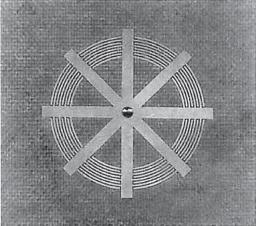
236 |
Design and practice of small antennas I |
|
|
Diameter: 30 mm
Figure 7.231 A CRLH loop resonant microstrip antenna ([116], copyright C 2008 IEEE).
7.2.5.2.2.3 Electric/Magnetic plane monopoles
A CRLH structure can be formed to have a closed circular loop configuration by folding a rectilinear CRLH structure as shown in Figure 7.231 [116]. This antenna in the zerothorder mode can be operated either as an electric or magnetic monopole by feeding to excite either ωsh or ωse mode. In the ωsh mode, Y = 0 (Eq. 7.74), and therefore the shunt paths are seen as open circuit, as the radial currents flowing on the stubs excite only LL, while the overall shunt resonator current is zero. This indicates that this antenna structure acts as an electric monopole. In turn, in the ωse mode, Z = 0 (Eq. 7.74), and therefore the series paths are seen as open circuit, and current flows exist only along the loop. This means that the antenna structure works as a magnetic loop. These two electric and magnetic monopoles are independent (uncoupled) from each other and may be excited simultaneously by using two different feeds (radial for ωse and azimuthal for ωsh).
A monopole radiator may also be realized by a zeroth-order CRLH resonator in a patch configuration [116]. In Figure 7.232 a CRLH magnetic monopole patch operating in the CRLH zeroth-order resonance mode (ωsh) is illustrated. This is a complement to the magnetic dipole of a conventional patch. The monopole is formed as a result of the magnetic currents (uniform vertical electric field) on the periphery of the mushroom patch. It may be possible to realize an electric monopole patch operating in the CRLH zeroth-order mode ωse.
7.2.5.2.3 NRI (Negative Refractive Index) TL MM antennas
When the top end of a quarter-wavelength monopole placed on a ground plane (GP) is folded back to the GPL (ground plane), the result is half a folded dipole, on which two mode currents, balanced and unbalanced, flow. As the balanced mode does not contribute to radiation and appears open at the input terminal, the unbalanced mode contributes to radiation, because the in-phase current flowing on both the feed terminal and its opposite side, becomes the meaningful part. The impedance seen at the feed terminal is four times that of the original monopole. Hence, the input impedance of a low-height monopole
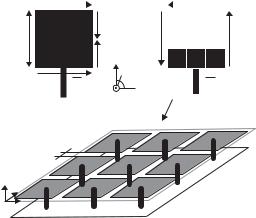
|
|
|
|
|
|
|
|
|
7.2 Design and practice of ESA |
237 |
|
|
|
|
|
|
|
|
|
|
|
|
|
|
|
|
|
|
|
|
|
|
|
|
|
|
|
|
|
|
|
|
|
|
|
|
|
|
|
|
|
|
|
|
|
|
|
|
|
|
|
|
|
|
|
|
|
|
|
|
|
|
|
|
|
|
y
conv. |
Ms |
|
z |
ϕ 
 x CRLH Ms
x CRLH Ms
δ
z y
x
Figure 7.232 A magnetic monopole microstrip patch antenna using the CRLH zeroth-order mode in a mushroom structure. ([116], copyright C 2008 IEEE).
can be increased by folding it and can be designed to match 50 . When a low-height monopole is folded, in-phase current on the resultant folded dipole cannot be obtained. In this case, a phase shifter is inserted, replacing the short at the top of the folded dipole to obtain in-phase currents so that a high enough input impedance to match 50 , even if the height is very low, and efficient radiation is achieved. A Negative Refractive Index (NRI) TL MM may be used as a substitute for such phase shifter and applied to realize a small, compact, yet efficient antenna.
7.2.5.2.3.1 MM ring antenna
An example of an NRI TL MM application to achieve a small antenna is a ring antenna operating at 1.77 GHz [120], which is constituted in a compact (λ0/11 footprint; λ0: operating wavelength) and low profile (λ0/28 height). Figure 7.233 shows the antenna structure and its geometry. The antenna consists of two MM unit cells, which are synthesized by using conventional TL loaded with lumped series capacitors and shunt inductors in a dual TL topology. The MM unit cells are arranged in a ring structure implemented by microstrip technology, and designed to produce in-phase currents on the posts (vias) connected to the antenna through the inductances at each end of the TL structure. Lumped inductors and capacitors connected to the TL give rise to series and shunt resonance respectively by involving the parasitic capacitance and inductance of the TL. The short vertical posts are connected to the antenna surface through the lumped inductor at each end of the TLs, and act as the radiation element. Even though the length of the post (radiator) is very small (λ0/28), the radiation resistance is adjusted to match 50 , and S11 obtained at the operating frequency of 1.77 GHz is nearly –30 dB. The lumped capacitance and inductance used, respectively, are 0.4 pF and 15 µH. The radiation pattern is similar to that of a short monopole, and gain and efficiency, respectively, are 1.245 dB and 54%. This is shown in Figure 7.234.

238 |
Design and practice of small antennas I |
|
|
z |
Holding brackets |
|
Metal TL
2Lo2
14.8 mm
Caps
2Lo1
13.1 mm
32 mil |
y |
x
6 mm
Via
Dielectric
Feed |
Ground plane |
Figure 7.233 Geometry of a metamaterial ring antenna ([120], copyright C 2005 IEEE).
330 |
E−Plane |
30 |
330 |
H−Plane |
30 |
0 |
0 |
300 |
|
|
|
60 |
300 |
|
|
|
−15 −5 |
5 |
|
270 |
−35 |
−25 |
90 |
270 |
|
|
|
||||
(a) |
|
|
|
|
(b) |
|
|
|
60 |
|
|
−15 −5 |
5 |
−35 |
−25 |
90 |
|
|
|
240 |
|
120 |
240 |
|
120 |
210 |
150 |
|
210 |
|
150 |
|
180 |
|
180 |
||
|
Eθ Measured |
|
E |
θ |
Measured |
|
Eθ Simulated |
|
Eθ Simulated |
||
|
Eϕ Measured |
|
Eϕ Measured |
||
|
Eϕ Simulated |
|
Eϕ Simulated |
||
Figure 7.234 Radiation patterns: (a) E-plane and (b) H-plane ([120], copyright C 2005 IEEE).
7.2.5.2.3.2 Multiple-folded monopole
An electrically small NRI TL MM antenna operating at 3 GHz band is introduced in [121]. The antenna consists of four folded monopoles, to which NRI TL MM technology is applied to realize a small, compact, and broadband antenna with very small
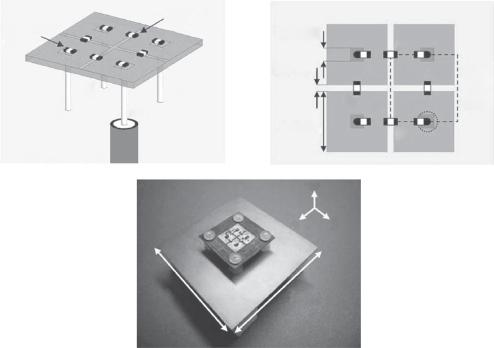
7.2 Design and practice of ESA |
239 |
|
|
|
Shunt |
Series |
|
|
|
|
|
|
capacitor |
|
|
|
|
|
|
|
inductor |
1.23 mm |
|
|
|
|
|
|
C0 |
|
|
|
|
||
|
L0 |
|
|
C0 |
|
||
|
|
|
|
|
|||
|
|
|
|
|
|
||
|
|
|
0.4 mm |
|
L0 |
L0 |
MTM |
(a) |
|
|
(b) |
|
|
|
|
Via |
|
|
|
|
unit |
||
|
|
|
|
|
|
||
|
Via |
Via |
|
C0 |
L0 |
L0 |
C0 cell |
|
Via |
|
|
|
|||
|
|
|
4.8 mm |
|
|
C0 |
|
|
Coaxial feed |
|
|
|
|
|
|
|
|
|
z |
|
|
|
|
|
|
|
x |
y |
|
|
|
|
|
(c) |
|
|
|
|
|
|
|
45 mm |
45 mm |
|
|
|
|
Figure 7.235 Electrically small NRI-TL metamaterial antenna: (a) perspective view, (b) top view, and (c) 3D view ([121], copyright C 2008 IEEE).
dimensions (λ0/10 × λ0/10 × λ0/10 over 0.45λ0 × 0.45λ0 ground plane; λ0: the operating wavelength). Figure 7.235 illustrates the antenna; (a) perspective view, (b) top view, and (c) 3D view. The NRI TL MM unit cell is constituted of a conventional TL, to which lumped capacitors and inductors are loaded to ensure series and shunt resonances respectively with parasitic inductance and capacitance inherently existing in the microstrip TL structure. By adjusting the values of the loaded elements and the unit cell size, amplitude and phase of signals propagating along an NRI TL structure can be aligned to obtain in-phase excitation of monopoles so that efficient radiation can be achieved. The monopoles are top-loaded with a square plate, on which the NRI TL MM structure is constituted, and consequently, appropriate radiation impedance to match 50 is attained even though the antenna height is very low. As can be seen in Figure 7.235(b), an NRI MM unit cell consists of a square plate, acting as a TL, to which a lumped inductance L0 is connected, and a lumped capacitance C0, bridging two TLs, thus resulting in an NRI TL MM.
Each of four square plates stands with a vertical post on a ground plane, one of which is the feeding post, and currents on each post are adjusted to be in-phase so that they are excited all in phase and efficient radiation can be obtained. It should be noted that use of folding monopole technology to increase the radiation resistance Rr, as was discussed in the previous section, is applied to this antenna structure, so obtained by placing an NRI MM between two posts.
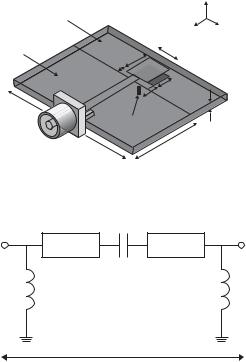
240 |
Design and practice of small antennas I |
|
|
|
|
z |
FR4 |
|
|
|
|
x y |
Ground |
Lm |
Wm,p |
|
h |
|
|
|
Lp |
|
|
Ls |
|
via |
hsub |
SMA |
Wg |
Lg |
connector |
|
|
|
|
Figure 7.236 NRI-TL metamaterial microstrip antenna ([122], copyright C 2002 IEEE).
θ/2 C0 θ/2
Z0 Z0
L01 |
L02 |
d
Figure 7.237 NRI-TL metamaterial π -unit cell ([122], copyright C 2009 IEEE).
For an antenna of N folded arms, the input impedance Rin is given by
Rin = N 2 Rr . |
(7.78) |
This antenna has four posts and Rr = 4 , if the post height is 5 mm, then λ0/20 at 3 GHz, Rin becomes 64 . This is sufficiently close in value to 50 for good matching. The antenna does not use a balun with the ground plane of 45 mm square. Simulated results by using HFSS show bandwidth of 42 MHz (−10dB), directivity of 1.31 dB and efficiency of 72.3%.
7.2.5.2.3.3 Dual-mode monopole antenna
An NRI TL MM unit cell employed in a small monopole to achieve a folded monopole structure and combined with a ground plane that acts as a radiator so as to obtain dual-mode operation is introduced in [122]. The antenna geometry and the dimensional parameters are illustrated in Figure 7.236. The total size of antenna is 20 mm × 30 mm. The MM unit cell is implemented by placing a small rectangular patch behind the printed monopole patch, which is equivalently expressed by a Pi-network shown in Figure 7.237. The series capacitance C0 is formed between these two patches and the shunt inductance L01 is formed at the base of the monopole, while L02 is formed by a thin inductive strip and a via that connects the patch behind the monopole patch and the ground plane (GP).
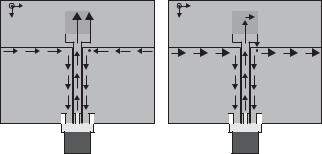
7.2 Design and practice of ESA |
241 |
|
|
z |
y |
|
x |
z |
y |
|
x |
(a) |
(b) |
Figure 7.238 Surface current distributions on the conductors of the MTM-loaded monopole antenna: (a) 5.5 GHz and (b) 3.55 GHz ([122], copyright C 2009 IEEE).
These elements are incorporated with TLs, which are comprised of the two monopole patches, to constitute a Pi MM unit cell. With this structure, currents flowing on these two patches can be arranged in-phase as Figure 7.238(a) shows, thus effectively a folded monopole structure is created, by which radiation resistance of the small monopole is increased. The original patch antenna (without MM loading) exhibits a single resonance at 6.3 GHz, whereas an MM-loaded monopole exhibits broadband dual resonance; these are a desired resonance at 5.5 GHz along with additional resonance at 3.55 GHz. The resonance around 3.55 GHz can be adjusted by changing the width of the GP.
At 3.55 GHz, the antenna acts as a dipole oriented along the y-axis, not as a folded monopole, because of the induced current on the top edge of the ground plane, which is shown in Figure 7.238(b). In the circuit shown in Figure 7.237, the TL section is negligible at the lower frequency and the circuit is simply transformed effectively into a series resonator, comprised of the capacitance C0 and the inductances L01 + L02. When the antenna is fed through L01, the series resonator represents an MM loaded monopole and forms a short circuit, thus acting as balun for the currents on the GP. Since the currents on both sides of the feed line are in-phase, the top edges of the ground plane radiate just as a dipole with a different polarization (orthogonal) to that of the MM monopole, which operates at 5.5 GHz.
Measured –10 dB bandwidth is 4.06 GHz, from 3.14 to 7.20 GHz, and efficiency is on the order of 90% at both 3.5 GHz and 5.5 GHz. Bandwidth increase as a result of loading the NRI MM to a monopole antenna is verified by comparison with bandwidth of the unloaded monopole antenna, which is 2.48 GHz from 5.35 to 7.83 GHz in terms of the –10 dB bandwidth.
By means of NRI TL MM loading to a conventional microstrip patch antenna, a compact, broadband, dual-radiation-mode antenna, that is, a short folded monopole operating at 5.5 GHz and a small dipole antenna operating at 3.55 GHz, is realized.
7.2.5.2.3.4 Tri-band monopole antenna
A planar monopole, to which an NRI TL MM structure is loaded, and a defected ground structure is employed, operating in three modes, is described in [123]. (A Defected
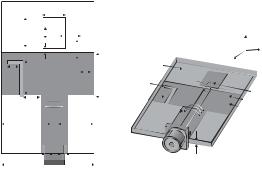
242 |
Design and practice of small antennas I |
|
|
|
|
|
|
|
|
|
|
Wm |
|
|
|
|
|
|
|
|
|
Lm |
WC1 |
|
LR1 |
|
|
|
z |
||||||
|
|
|
|
|
|
||||||||||
|
|
|
|
|
|
|
|
|
y |
||||||
|
|
|
|
|
|
|
|
|
|
|
|
|
|
|
|
|
|
|
|
|
|
|
|
|
|
|
|
|
|
|
|
|
|
|
|
|
|
h |
|
|
|
|
|
FR4 |
x |
||
|
|
|
|
|
|
|
LR2 |
|
|
|
|||||
|
|
|
|
|
|
|
|||||||||
Ls2 |
|
|
|
|
Lg |
L1 |
|||||||||
Ls1 |
|
|
|
|
|
||||||||||
W |
Slot |
||||||||||||||
|
|
|
|
|
|
|
|
|
|
C2 |
|
|
|
C1 |
|
|
|
|
|
|
|
|
|
|
|
|
|
Ground |
|
||
|
|
|
|
|
|
|
|
|
|
|
|
||||
|
|
|
W |
|
|
|
|
Air |
|
|
L2 |
||||
|
|
|
|
S1 |
|
Wg2 |
|
|
C2 |
||||||
|
|
Wg1 |
|
|
bridge |
|
|
||||||||
|
|
|
|
|
|
|
|
|
|
|
|
|
|
||
|
|
|
|
|
|
|
|
|
|
|
|
|
SMA |
|
|
|
|
|
|
|
|
|
|
|
|
|
|
connector |
|
|
|
|
|
|
W |
g |
|
|
|
|
|
|
|
hsub |
|||
|
|
|
|
|
|
|
|
|
|
|
|
||||
|
|
|
|
|
|
|
|
|
|
||||||
|
|
|
|
|
|
(a) |
|
|
|
|
|
(b) |
|||
Figure 7.239 Tri-band monopole antenna with single-cell MTM loading and a defected-ground plane: (a) top view and (b) 3D view. ([123], copyright C 2010 IEEE).
Ground Structure (DGS) is defined as a unit cell EBG or an EBG with limited number of cells and a period.) The antenna geometry and the dimensional parameters are illustrated in Figure 7.239, where (a) is top view and (b) is 3D view. A coplanar waveguide (CPW)- fed monopole antenna is loaded with a single NRI TL MM-based Pi-unit cell. The series capacitance C1 is formed between the monopole on the top of the substrate and the rectangular patch placed opposite to the monopole. The TL MM cell is asymmetrically loaded with two shunt inductances, L1 and L2. As can be seen in Figure 7.239, L1 is formed by the inductive strip to feed the monopole and L2 is formed by the thin inductive strip that connects the rectangular patch beneath the monopole to the rectangular patch beneath the RH ground plane (GP). A capacitance C2, formed between the rectangular patch and the RH GP, connects the shunt inductor L2 to the ground. By appropriately adjusting these parameters in addition to the geometrical parameters of the antenna, current flows on the feed strip (L1) to the monopole and the inductive strip (L2) to the rectangular patch behind the monopole, can be made in-phase at the resonance frequency, thus the antenna performs effectively as a two-arm folded monopole. Figure 7.240(a) shows the current flows with arrows and indicates the antenna operates in the folded monopole mode. The resonance frequency in this case is around 5.0 GHz–6.0 GHz.
In this antenna structure loaded with an NRI TL MM, resonance occurs at lower frequency around 2.4 GHz–2.5 GHz in addition to the higher frequency with other modes. Major current flows on the GP are depicted in Figure 7.240(b), which shows that the currents along the CPW feed line are symmetric, while those on the upper edges of the GP are in-phase. This means that the currents on the edges of the GP contribute radiation and the antenna effectively performs as a dipole, which radiates in a direction orthogonal to that of the monopole mode. The in-phase currents on the top edges of the GP are produced by designing the series circuit comprising C1, C2, L1 and L2 to resonate at a frequency that overlaps with the dipole mode resonance, as the series circuit becomes short. The resonance frequency depends on the length of the current path, related with the size of the GP, Wg + 2Lg, (Figure 7.239). Based on the design consideration discussed above, the optimized loading patches have dimensions
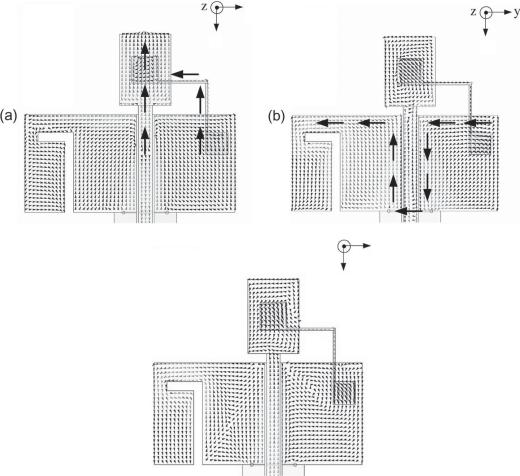
7.2 Design and practice of ESA |
243 |
|
|
z |
y |
|
|
|
|
|
z |
|
y |
||
|
|
|
|
||
|
|
|
|
|
|
x |
x |
|
|
|
|
(a) |
|
(b) |
|
|
|
|
|
|
z y
x
(c)
Figure 7.240 Current distributions on the conductor of the tri-band monopole antenna shown in Figure 7.239: (a) folded monopole mode (5.80 GHz), (b) dipole mode (2.44 GHz), and (c) effect of defected ground plane (3.76 GHz) ([123], copyright C 2010 IEEE).
of 3.0 mm × 3.0 mm and 2.5 mm × 2.5 mm, respectively, and the two sections of thin strips have the same length of 5.5 mm and width of 0.25 mm. As the current flow takes a longer path than the length of the edge of the GP, a lower resonance frequency is achieved in comparison with the antenna introduced in the previous section [122], where the dipole-mode currents flow only on the top edges of the GP. This implies that a larger miniaturization factor is attained by this antenna structure.
In addition to the dipole mode, the antenna is designed to perform with a third mode, which is achieved by using a defected GP structure, formed by cutting an L-shaped slot out on the left-side of the CPW on the GP as shown in Figure 7.240. With this slot, resonance occurs around 3.5 GHz, while the dual-mode operation at around 2.5 GHz and 6.0 GHz is preserved. Current distributions on the GP at the resonance frequency
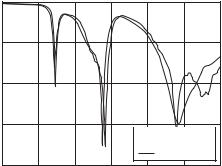
244 |
Design and practice of small antennas I |
|
|
|S11| (dB)
0
–10
–20
–30 

 Simulated
Simulated
Measured
–40
1 |
2 |
3 |
4 |
5 |
6 |
7 |
Frequency (GHz)
Figure 7.241 Simulated and measured return loss ([123], copyright C 2010 IEEE).
3.76 GHz are shown in Figure 7.240(c), which illustrates a strong concentration of the currents that flow so as to wrap around the L-shaped slot on the left-side of the GP, thus taking a longer path of approximately λg/2 at the resonance of the third mode. The vertical and horizontal length of the slot Ls1 and Ls2, respectively, are adjusted to achieve a good impedance match throughout the 3.5 GHz band. The slot is located far enough away from the CPW so that it does not affect the balanced CPW mode.
Tri-band performance of this antenna is shown by the return-loss S11 characteristics of a fabricated antenna as Figure 7.241 illustrates. In the figure, measured and simulated S11 values are given by the dark line and dotted line, respectively. The measured –10dB bandwidths are 90 MHz for the 2.5 GHz band, 5.20 GHz to beyond 7 GHz for the 5.5 GHz band, and 620 MHz for the 3.5 GHz band. Each band corresponds to the lower and higher band of WiFi, and WiMAX band, respectively. The measured radiation efficiencies are 67.4% at 2.45 GHz, 86.3% at 3.5 GHz, and 85.3% at 5.5GHz. The full size of the antenna is 20.0 mm × 23.5 mm × 1.59 mm (or λ0/6.3 × λ0/5.3 × λ0/78.6 with respect to the lowest resonant frequency of 2.45 GHz), including the GP size Lg × Wg = 11.0 mm × 23.5 mm.
7.2.5.2.3.5 Multi-frequency and dual-mode patch antenna
A microstrip square patch antenna, to which a CRLH structure is partially filled, enabling multi-frequency and dual-mode operation with miniaturized dimensions, is introduced in [124]. The antenna geometry and the structure are shown in Figure 7.242. As can be seen in the figure, the CRLH structure is implemented by using mushroom structures, the unit cell of which is composed of metal patches with vias to the GP (ground plane), forming an inductance LL, and gaps between adjacent cells, forming a coupling capacitance CL. The LH performance of these cells is provided by these equivalent circuit parameters, LL and CL, while the current flux (LR) and the parallel plate capacitor between the metal patch and the GP (CR) render the RH nature. Rectangular patch rather than square patch will be used, because by using its longer side, larger coupling between

7.2 Design and practice of ESA |
245 |
|
|
Dielectric Ground plane
Vias
Coax feed |
Metal patches Gaps |
y |
 x
x
z
g1

 d Wm w
d Wm w
 Lm
Lm 
 g2
g2
L
|
Metal patches |
h |
Dielectric |
|
Ground plane |
Coax probe |
Vias |
Figure 7.242 Microstrip patch antenna partially filled with a 2 × 1 arrangement of CRLH cells ([124], copyright C 2008 IEEE).
adjacent cells is obtained, giving lower operating frequency and leading to miniaturization of the antenna.
Meanwhile, the square patch is a conventional microstrip antenna, which is modeled as an open-ended TL resonator, composed equivalently with a series inductance Lms and a shunt capacitance Cms. The propagation constant βRH along this RH TL structure is expressed by
βRH = ω Lms Cms . (7.79)
The square patch partially loaded with a CRLH structure is treated as a combined TL of two RH and one LH TL structures. An open ended or short circuited RH + LH + RH TL works as a resonator that exhibits a behavior similar to a CRLH resonator at lower

246Design and practice of small antennas I
frequencies and a RH resonator at higher frequencies. The propagation constant along the LH section is given by
βLH = −1/( pω L L CL ) (7.80)
where p denotes the length of the unit cell, smaller than λg/4 and LL and CL, respectively, are inductance and capacitance per unit cell. The antenna is designed to operate at three modes, n = ± 1 and 0.
At lower frequencies, where |βLH| > |βRH|, an antenna with a mode n = –1 can be obtained as β–1 L = – π (β–1: the propagation constant along the TL of the length L at n = –1, and L: the length of the RH + LH + RH TL structure). The antenna operates here with a fundamental mode just as a conventional patch, which has two radiating slots having the same amplitude and opposite phase, thus the radiation pattern is dipolar.
As the frequency increases, βLH increases, while βRH decreases. Then, a mode n = 0 can be excited by making βLH + βRH = β0 L = 0. The electric field distribution of this mode is constant, and so two radiation slots of the patch have the same amplitude and phase, leading to a monopole-like radiation at the resonance frequency f0.
At frequencies higher than f0, |βLH| is greater than |βRH| and thus the resonance condition for n = +1 mode can be achieved, where β+1 L = + π . This mode has the same field distribution and radiation property as the fundamental mode of the conventional patches.
Since the frequencies of the lower modes n ≤ 0 depend on the CRLH (mushroom) structure, desired operating frequencies at lower bands are obtained by appropriate design of the mushroom structure.
For desired operating frequencies at higher bands, as the frequencies at higher mode n = +1 depend on the patch itself, the patch dimensions are so designed as the conventional patch without mushroom.
The proposed antenna having dimensions of (L × W) = 42 mm × 42 mm, the substrate with εr = 2.2 and thickness h = 10 mm is used. The mushroom structure is comprised with a 2 × 1 cell array and has the dimensions (Lm × Wm) 10.6 mm × 17.8 mm, the gap between the two mushrooms is 0.40 mm, and the separation gap between the LH structure and the microstrip patch is 0.2 mm. The diameter of the vias is 0.7 mm. The coaxial feed probe is placed 14 mm from the center and the size of the GP is 80 mm × 80 mm. These dimensional parameters are chosen to obtain the resonant frequencies at 1 GHz for the n = –1 mode, used in GSM (Global Systems for Mobile Communications), at 1.5 GHz for the n = 0 mode, used in navigation systems, and 2.2 GHz for n = +1 mode, used in UMTS (Universal Mobile Telephone Systems).
Experimental results are: for n = –1 mode (f0 = 1.06 GHz), D (directivity) = 4.5 dB, G (Gain) = –3 dB, E (efficiency) = 17.8%, and BW (–6 dB bandwidth) = 3%; for the n = 0 mode (f0 = 1.45 GHz), D = 5.1 dB, G = 1 dB, E = 39%, BW = 3%; and for the n = +1 mode (f0 = 2.16 GHz), D = 7.4 dB, G = 6.5 dB, E = 82%, and BW = 13%. The lengths of the antenna in terms of the resonance frequency are λ0/6.74, λ0/4.92, and λ0/3.31 for the mode n = –1, 0, and +1, respectively, indicating that at the lower modes, significant reduction of the antenna size is observed compared with the conventional λ/2 patch antenna. The antenna presents two dipole modes (n = ±1) and one monopole
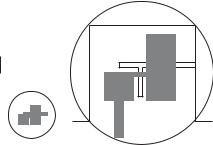
7.2 Design and practice of ESA |
247 |
|
|
Antenna
 y
y
 x
x
|
|
|
|
Feeding |
|
|
|
|
|
||
Ground |
|||||
line |
|||||
plane |
|||||
|
|||||
|
|
|
|
|
|
Figure 7.243 Geometry of the RH/LH TLs loaded planar antenna ([125], copyright C 2008 IEEE).
mode (n = 0), and radiation patterns at the different operating modes are dipolar and monopolar.
A dual-frequency patch antenna, which aims at application to DCS at 1.8 GHz and UMTS at 2.2 GHz, was designed by using the same concept and an example is shown in [124]. In this case, a 2 × 2 CRLH structure is employed so that the two modes are excited, excluding n = 0 mode. The mushroom configuration was changed to be square and the number of cells was increased to four. The dimensions of this antenna are larger than the first one, with length of λ0/3.44 at the lower frequency and λ0/2.83 at the higher frequency. With increased size, efficiency of the antenna is made higher (60%) than the first one for n = –1.
7.2.5.2.3.6 Compact CRLH MM-loaded slot antenna
A planar antenna utilizing cascaded RH/LH TLs to realize compact size is introduced in [125]. The antenna geometry is depicted in Figure 7.243, where the constitutive elements of the RH/LH TL are shown by black parts (printed capacitors) and slots (inductors). The RH TL consists of a series inductance and a shunt capacitance in a Pi-network structure, while the LH TL consists of a series capacitance and a shunt inductance in a T-network structure. They are connected with an open-circuit at the unconnected port of the LH TL, by which the TL works as a resonator. Along the power travelling direction, the RH and LH TLs have opposite phase property from each other, hence a ZOR (zeroth-order resonance) structure can be formed and the size of the antenna can be designed arbitrarily without regard to the wavelength since it is specified by the circuit parameters. The circuit elements are realized by using printed elements. The size of printed patches is designed to have proper capacitance against the ground, while the length of the metal traces or the size of slots on the ground plane is designed to create required inductance. The realized proposed antenna of straight type is shown in Figure 7.244. Layout of the antenna of L-shaped type is illustrated in Figure 7.245(a), in which dark lines show the top metal part and dotted lines give the bottom metal part. In the figure, (a) shows that three patches on the top metal part realize capacitances C1, C2, and C3, respectively, and two narrow metal slots placed on the bottom metal, which
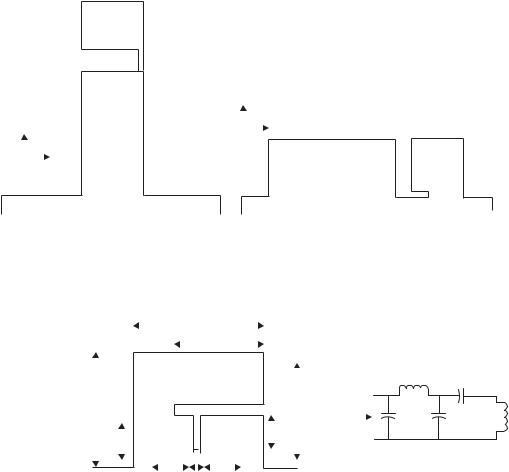
248 |
Design and practice of small antennas I |
|
|
|
|
|
|
C3 |
|
|
|
|
|
|
|
|
|
|
|
|
|
|
|
|
|
|
|
|
|
|
|
|
|
|
|
|
|
|
|
|
|
|
|
|
|
|
||||
|
|
|
|
|
|
|
|
|
|
L2 |
|
|
|
|
|
|
|
|
|
|
|
|
|
|
|
|
|
|
|
|
|
|
|
|
|
|
|
|
|
|
|
|
|
|||
|
|
|
|
C2 |
|
|
|
|
|
|
|
|
|
|
|
|
|
|
|
|
|
|
|
y |
|
|
|
|
|
|
|
|
||||||||||||||
y |
|
|
|
|
|
|
|
|
|
|
|
|
|
|
|
|
|
|
|
|
|
|
|
|
|
|
|
|
|
|
|
x |
|
|
|
|
|
|
|
|
||||||
|
|
|
|
|
|
|
|
|
|
|
|
|
|
|
|
|
|
|
|
|
|
|
|
|
|
|
|
|
|
|
|
|
|
|
|
|
|
|
||||||||
|
|
|
|
L1 |
|
|
|
|
|
|
|
|
|
|
|
|
|
|
|
|
|
|
|
|
|
|
|
|
|
|
|
|
|
|
|
|
||||||||||
|
|
|
|
|
|
|
|
|
|
|
|
|
|
|
|
|
|
|
|
|
|
|
|
|
|
|
|
|
|
|
|
|
|
|
|
|
||||||||||
|
x |
|
|
|
|
|
|
|
|
|
|
|
|
|
|
|
|
|
|
|
|
|
|
|
|
|
|
|
|
|
|
|
|
|
|
|
|
|
|
|
|
|
|
|
|
|
|
|
|
C1 |
|
|
|
|
|
|
|
|
|
|
|
|
|
|
|
|
|
|
|
|
|
|
|
|
|
C1 |
|
L1 |
|
C2 |
|
C3 |
|
||||||||||
|
|
|
|
|
|
|
|
|
|
|
|
|
|
|
|
|
|
|
|
|
|
|
|
|
|
|
|
|
|
|
|
|
|
|||||||||||||
|
|
|
|
|
|
|
|
|
|
|
|
|
|
|
|
|
|
|
|
|
|
|
|
|
|
|
|
|
|
|
|
|
|
|
|
|
|
|
||||||||
|
|
|
|
|
|
|
|
|
|
|
|
|
|
|
|
|
|
|
|
|
|
|
|
|
|
|
|
|
|
|
|
|
|
|
|
|
|
|
|
|
|
|
|
|
|
|
|
|
|
|
|
|
|
|
|
|
|
|
|
|
|
|
|
|
|
|
|
|
|
|
|
|
|
|
|
|
|
|
|
|
|
|
|
|
|
|
|
|
|
|
|
L2 |
|
|
|
|
|
|
|
|
|
|
|
|
|
|
|
|
|
|
|
|
|
|
|
|
|
|
|
|
|
|
|
|
|
|
|
|
|
|
|
|
|
|
|
|
|
|
|
|
|
|
|
|
|
|
|
|
|
|
|
|
|
|
|
|
|
|
|
|
|
|
|
|
|
|
|
|
|
|
|
|
|
|
|
|
|
|
|
|
|
|
|
|
|
|
|
|
|
|
|
|
(a) |
|
|
|
|
|
|
|
|
|
|
|
|
|
|
|
|
|
|
|
|
|
|
|
|
|
|
|
|
(b) |
|
|
|
|||||||||
|
Figure 7.244 Layout of straight type antenna, (a) horizontal arrangement and (b) vertical |
|||||||||||||||||||||||||||||||||||||||||||||
|
arrangement ([125], copyright C 2005 IEEE). |
|
|
|
|
|
|
|
|
|||||||||||||||||||||||||||||||||||||
|
|
|
|
|
|
|
|
|
|
|
|
|
|
|
|
|
|
|
|
W |
|
|
|
|
|
|
|
|
|
|
|
|
|
|
|
|
|
|
|
|
|
|
||||
|
|
|
|
|
|
|
|
|
|
|
|
|
|
|
|
|
|
|
|
|
|
|
|
|
Ls1 |
|
|
|
|
|
|
|
|
|
|
|
|
|
|
|
|
L1 |
|
C3 |
||
|
|
|
|
|
|
|
|
|
|
|
|
|
|
|
|
|
|
|
|
|
|
|
|
|
|
|
|
|
|
|
|
|
|
|
|
|
|
|
|
|
|
|
|
|
||
|
|
|
|
|
|
|
|
|
|
|
|
|
|
|
|
|
|
|
|
|
|
|
|
|
|
|
|
|
|
|
|
|
|
|
|
|
|
|
|
|
|
|
|
|
||
|
|
|
|
|
|
|
|
|
|
|
|
|
|
|
|
|
|
|
|
|
|
|
|
|
|
|
|
|
|
|
|
|
|
|
|
|
|
|
|
|
|
|
|
|
||
|
|
|
|
|
|
|
|
|
|
|
|
|
|
|
|
|
|
|
|
|
|
|
|
|
C3 |
|
|
|
|
|
|
|
|
|
|
|
|
|
|
|
|
|
||||
|
|
|
|
|
|
|
|
|
|
|
|
|
|
|
|
|
|
|
|
|
|
|
|
|
|
|
|
|
|
|
|
|
|
|
|
|
|
|
|
|
|
|
||||
|
|
|
|
|
|
|
|
|
|
|
|
L2 |
|
|
|
|
|
|
|
|
|
|
|
|
|
|
|
|
|
|
|
|
|
|
||||||||||||
|
(a) L |
|
|
|
|
|
|
|
|
|
|
|
|
|
|
|
|
|
|
|
|
|
|
|
|
|
|
|
|
|
|
|
|
|
|
|||||||||||
|
|
|
|
|
|
|
|
|
|
|
|
|
|
|
|
|
|
|
|
|
|
|
|
|
|
|
|
|
|
|
|
|
|
|
L |
|
|
|
|
|
|
|
L2 |
|||
|
|
|
|
|
|
|
|
|
|
|
|
|
|
|
|
|
|
|
|
|
|
|
|
|
|
|
|
|
|
|
|
|
|
|
|
|
|
s3 |
|
|
|
|
|
|
||
|
|
|
|
|
|
|
|
|
|
|
|
|
|
|
|
|
|
|
|
|
|
|
L |
1 |
|
|
|
|
|
|
|
Ls2 |
|
|
|
|
(b) |
|
|
|
C1 |
C2 |
||||
|
|
|
|
|
|
|
|
|
|
|
|
|
|
|
|
|
|
|
|
|
|
|
|
|
|
|
|
|
|
|
|
|
|
|
|
|
|
|
|
|
|
|
||||
|
|
|
|
w |
|
|
|
|
|
C1 |
|
|
|
|
|
|
C2 |
|
|
|
|
|
|
|
|
|
|
Zin |
|
|
|
|||||||||||||||
|
|
|
|
|
|
|
|
|
|
|
|
|
|
|
|
|
|
|
|
|
|
|
|
|
|
|
|
|
|
|
||||||||||||||||
|
|
|
|
|
|
|
|
|
|
|
|
|
|
|
|
|
|
|
|
|
|
|
|
|
|
|
|
|
||||||||||||||||||
|
|
|
|
|
c |
|
|
|
|
|
|
|
|
|
|
|
|
|
|
|
|
|
|
|
|
|
|
|
|
|
|
|
|
|
|
|
|
|
|
|
|
|
|
|
|
|
|
|
|
|
|
|
|
|
|
|
|
|
|
|
|
|
|
|
|
|
|
|
|
|
|
|
|
|
|
|
|
|
|
|
|
|
|
|
|
|
|
|
|
|
|
|
|
|
|
|
|
|
|
|
|
|
|
wc |
|
|
|
|
|
g |
wc |
|
|
|
|
|
|
|
|
|
|
|
|
|
|
|
|
|
|
|
|
|||||||||
|
|
|
|
|
|
|
|
|
|
|
|
|
|
|
|
|
|
|
|
|
|
|
|
|
|
|
|
|
|
|
|
|
|
|
|
|
|
|
|
|
|
|
|
|
|
|
Figure 7.245 Layout of L-shaped type (a) the composition of metamaterial components and (b) the equivalent circuit of a π -model for RH TL and a T-model for LH TL ([125], copyright C 2008 IEEE).
is considered as the ground plane (GP), produce inductances L1 and L2. A closed loop is formed by these elements, on which current flows in order of C1, L1, C2, C3, and L2, and then back to C1. The dimensional parameters (in mm) are L = W = 11.5, wc = 4, Ls3 = 9.5, g = 1.3, Ls1 = 7.2, Ls2 = 3.2, and the slot (L1) width is 0.5. The size of the GP is 40 mm × 30 mm. All three capacitances are designed to have the same value 2.6 pF and both inductances have the same value of 1.62 nH. The equivalent circuit consisting of these circuit elements is given in Figure 7.245(b). Magnetic currents flow around C2 and C3, but currents on both sides have opposite phase and do not contribute to radiation, while the top sides of both elements operate as the radiating edges, and contribute to radiation. Since the field produced by C1 is very weak, it is not taken into
